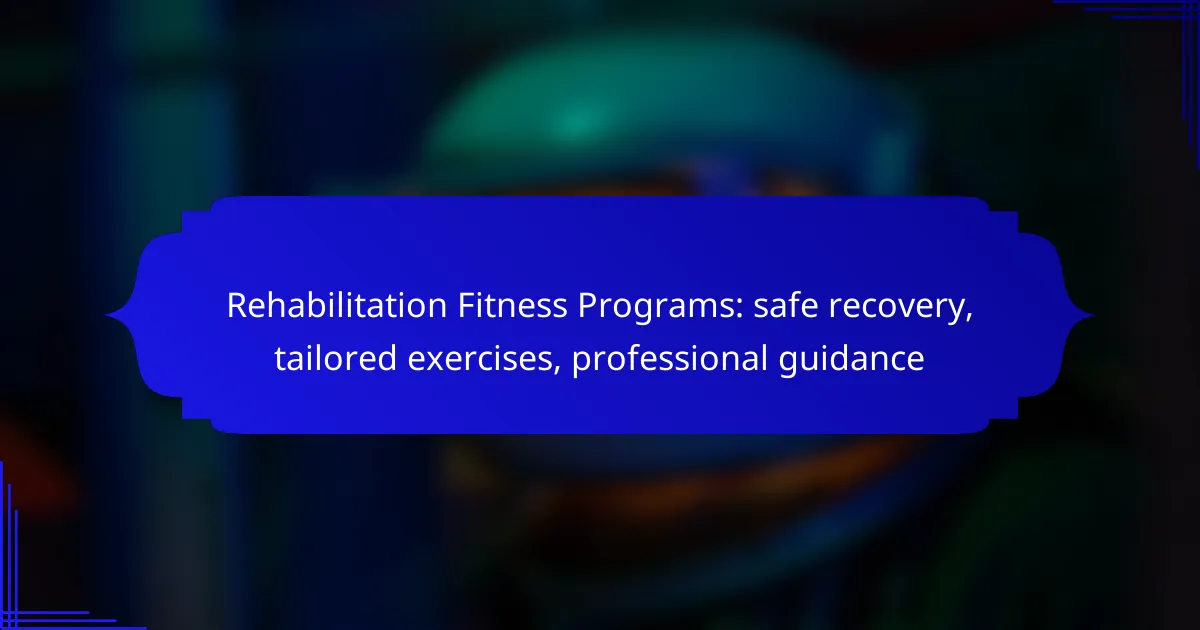Rehabilitation fitness programs are essential for ensuring safe recovery through personalized exercise regimens and expert guidance. By focusing on individual needs, these programs not only promote effective rehabilitation but also significantly reduce the risk of re-injury. Tailored exercises enhance strength, flexibility, and overall physical function, creating a comprehensive approach to healing.

What are the best rehabilitation fitness programs in Canada?
The best rehabilitation fitness programs in Canada focus on safe recovery through tailored exercises and professional guidance. These programs are designed to meet individual needs, ensuring effective rehabilitation while minimizing the risk of re-injury.
Physiotherapy-based programs
Physiotherapy-based programs are centered around physical therapists who assess and create personalized exercise plans. These plans often include manual therapy, modalities like ultrasound or electrical stimulation, and specific exercises to improve strength and mobility.
In Canada, physiotherapy is regulated, ensuring practitioners meet high standards. Patients should seek programs that incorporate regular assessments to track progress and adjust the plan as needed.
Post-surgery recovery programs
Post-surgery recovery programs are essential for individuals recovering from operations such as joint replacements or repairs. These programs typically begin with gentle movements and progress to more challenging exercises as healing occurs.
Patients should follow their surgeon’s recommendations closely and work with a rehabilitation specialist to ensure a safe return to daily activities. Regular follow-ups can help monitor recovery and adapt the program accordingly.
Sports injury rehabilitation
Sports injury rehabilitation programs focus on restoring function and strength after injuries like sprains, fractures, or tendonitis. These programs often include sport-specific exercises to help athletes return to their activities safely.
In Canada, many facilities offer specialized trainers who understand the demands of various sports. It’s crucial for athletes to communicate their goals and any pain experienced during rehabilitation to ensure proper adjustments are made.
Chronic pain management programs
Chronic pain management programs aim to help individuals cope with long-term pain through a combination of physical activity, education, and psychological support. These programs often include low-impact exercises, mindfulness techniques, and lifestyle modifications.
Patients should seek programs that emphasize a multidisciplinary approach, allowing for comprehensive care. Regular evaluations can help adjust strategies to improve pain management effectively.
Senior fitness rehabilitation
Senior fitness rehabilitation programs are tailored for older adults, focusing on improving mobility, strength, and balance to prevent falls. These programs often include gentle exercises, flexibility training, and functional activities relevant to daily living.
In Canada, it’s important for seniors to participate in programs led by certified professionals who understand age-related changes and can adapt exercises accordingly. Regular assessments can help ensure safety and effectiveness in the rehabilitation process.

How do rehabilitation fitness programs ensure safe recovery?
Rehabilitation fitness programs prioritize safe recovery by integrating tailored exercises, professional guidance, and ongoing assessments. These elements work together to create a supportive environment that fosters healing while minimizing the risk of injury.
Personalized assessments
Personalized assessments are crucial in rehabilitation fitness programs as they evaluate an individual’s specific needs, limitations, and goals. These assessments often include physical evaluations, medical history reviews, and functional movement screenings to identify areas requiring focus.
By understanding each participant’s unique situation, fitness professionals can design customized exercise plans that cater to their rehabilitation journey. This tailored approach enhances the effectiveness of the program and promotes safer recovery outcomes.
Supervised exercise sessions
Supervised exercise sessions provide participants with professional guidance during their workouts, ensuring they perform exercises correctly and safely. Trained instructors monitor movements, offer real-time feedback, and make adjustments as necessary to prevent strain or injury.
These sessions typically include a mix of strength training, flexibility exercises, and cardiovascular activities, all tailored to the individual’s recovery stage. Regular supervision helps maintain motivation and accountability, which are essential for successful rehabilitation.
Regular progress evaluations
Regular progress evaluations are integral to rehabilitation fitness programs, allowing both participants and trainers to track improvements and adjust plans as needed. These evaluations may occur weekly or bi-weekly, depending on the program’s structure and the individual’s recovery pace.
During these evaluations, fitness professionals assess physical improvements, discuss any challenges faced, and modify exercise regimens to align with evolving recovery goals. This ongoing feedback loop ensures that the rehabilitation process remains effective and responsive to the participant’s needs.

What tailored exercises are included in rehabilitation fitness programs?
Rehabilitation fitness programs typically include a variety of tailored exercises designed to promote safe recovery and improve physical function. These exercises focus on strength, flexibility, cardiovascular health, and balance, ensuring a comprehensive approach to rehabilitation.
Strength training exercises
Strength training exercises in rehabilitation programs are designed to rebuild muscle strength and endurance. Common exercises include bodyweight movements like squats and push-ups, as well as resistance band exercises that can be adjusted for intensity. Aim for 2-3 sessions per week, focusing on major muscle groups.
Start with lighter weights or resistance and gradually increase as strength improves. Always prioritize proper form to prevent injury, and consider working with a professional to ensure exercises are appropriate for your specific condition.
Flexibility and stretching routines
Flexibility and stretching routines are essential for improving range of motion and reducing stiffness. These routines often include static stretches for major muscle groups, such as hamstrings, quadriceps, and shoulders. Incorporating these stretches 3-5 times a week can enhance recovery and mobility.
Hold each stretch for 15-30 seconds, and avoid bouncing to prevent injury. Gentle yoga or Pilates can also be beneficial, promoting both flexibility and relaxation during the rehabilitation process.
Cardiovascular conditioning
Cardiovascular conditioning exercises help improve heart health and overall endurance, which is vital during recovery. Low-impact activities such as walking, cycling, or swimming are often recommended, allowing for safe engagement without excessive strain on the body.
Start with sessions lasting 10-20 minutes, gradually increasing duration and intensity as fitness improves. Aim for at least 150 minutes of moderate aerobic activity per week, adjusting based on individual capabilities and recovery progress.
Balance and coordination drills
Balance and coordination drills are crucial for preventing falls and enhancing stability, especially after injury. Exercises may include single-leg stands, heel-to-toe walking, and using balance boards. These drills can be integrated into daily routines to reinforce stability.
Practice these exercises 2-3 times a week, focusing on maintaining control and proper posture. Progress can be made by increasing difficulty, such as closing your eyes or performing movements on unstable surfaces.

Who provides professional guidance in rehabilitation fitness?
Professional guidance in rehabilitation fitness is typically provided by trained specialists who understand the complexities of recovery. These experts create tailored exercise programs that ensure safety and effectiveness during the rehabilitation process.
Certified physiotherapists
Certified physiotherapists are healthcare professionals who specialize in movement and function. They assess individual needs and design rehabilitation programs that address specific injuries or conditions, focusing on restoring mobility and strength.
During sessions, physiotherapists may use techniques such as manual therapy, exercises, and modalities like ultrasound or electrical stimulation. They also educate patients on proper body mechanics to prevent future injuries.
Licensed personal trainers
Licensed personal trainers play a crucial role in rehabilitation fitness by providing personalized exercise plans that align with recovery goals. They are trained to adapt workouts based on individual capabilities and limitations, ensuring a safe progression.
These trainers often collaborate with physiotherapists to implement strength training, flexibility exercises, and cardiovascular workouts. It’s essential to choose trainers with experience in rehabilitation to avoid exacerbating injuries.
Occupational therapists
Occupational therapists focus on helping individuals regain the skills needed for daily living and work activities. They assess how injuries impact daily tasks and design interventions that promote independence and functionality.
Therapists may incorporate exercises that improve fine motor skills, coordination, and cognitive functions. They often provide adaptive strategies and tools to facilitate recovery, ensuring that patients can return to their routines safely.

What are the prerequisites for joining a rehabilitation fitness program?
Joining a rehabilitation fitness program typically requires medical clearance and an initial fitness assessment. These steps ensure that the program is safe and tailored to individual recovery needs.
Medical clearance
Medical clearance is essential before starting a rehabilitation fitness program. This involves obtaining a written approval from a healthcare provider, confirming that you are fit to engage in physical activity. The provider will assess your medical history, current health status, and any specific limitations.
Common conditions that may require special consideration include cardiovascular issues, orthopedic injuries, or chronic illnesses. Always disclose any medications or treatments you are undergoing, as these can impact your ability to participate safely.
Initial fitness assessment
An initial fitness assessment evaluates your current physical capabilities and identifies areas that need focus during rehabilitation. This assessment may include tests for strength, flexibility, endurance, and balance. The results help in designing a personalized exercise plan that aligns with your recovery goals.
Typically, the assessment is conducted by a qualified fitness professional or physical therapist. They will use the findings to recommend appropriate exercises and monitor your progress throughout the program. Regular re-assessments can help adjust the program as needed to ensure continued improvement and safety.

How to choose the right rehabilitation fitness program?
Selecting the appropriate rehabilitation fitness program involves assessing your specific recovery needs, fitness level, and personal goals. A tailored approach, guided by professionals, ensures safe and effective recovery through appropriate exercises.
Assess your specific needs
Begin by evaluating your injury or condition to understand what areas require focus. Consider factors such as pain levels, mobility restrictions, and overall fitness. Consulting with a healthcare provider can help clarify your needs and guide you toward suitable programs.
For example, someone recovering from knee surgery may need a program emphasizing low-impact exercises, while a person with back pain might focus on core strengthening. Identifying these specifics will help narrow down your options.
Consider your fitness level
Your current fitness level plays a crucial role in choosing a rehabilitation program. Programs should match your abilities to avoid injury and promote gradual improvement. Beginners may need more foundational exercises, while those with higher fitness levels can engage in more challenging routines.
It’s beneficial to start with a program that offers modifications for different fitness levels. This ensures you can progress safely and effectively as your strength and mobility improve.
Seek professional guidance
Engaging with qualified professionals, such as physical therapists or certified trainers, is essential for a safe rehabilitation process. They can design a customized program that aligns with your recovery goals and monitor your progress.
Look for programs that include regular assessments and adjustments based on your development. This professional oversight helps prevent setbacks and ensures that you are performing exercises correctly to maximize benefits.
